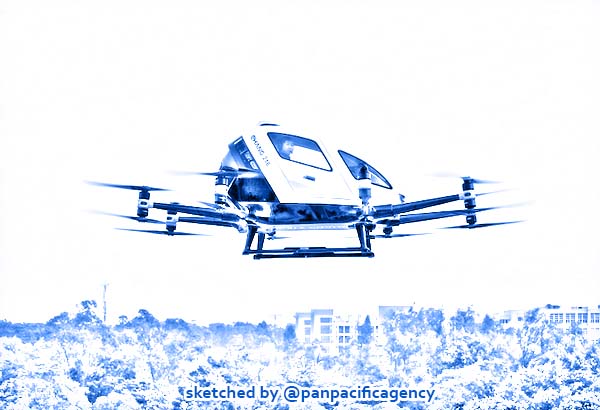[Analytics] Guangzhou testing small passenger drones

An EHang passenger drone. Photo: Handout. Sketched by the Pan Pacific Agency.
The modes of transportation in Guangzhou, the largest urban center in southern China, are multi-layered.
Underground, the city boasts a sprawling metro network with a total length longer than the New York City subway. On the ground, several expressways and major thoroughfares intersect the city to divert traffic. And above them, a swirl of flyovers and interchanges are being added as shortcuts and alternative lines to tackle congestion. Frank Chen specially for the Asia Times.
But the nearly three million private cars in this commerce and manufacturing boomtown mean tailbacks along trunk routes are still getting longer as commuting becomes a crawl.
Now Guangzhou cadres who are usually stuck in slow traffic are pinning high hopes on a fleet of compact helicopters and passenger drones from a local tech startup to get them over the congestion.
Novel autonomous aerial vehicles are set to take to the skies in Guangzhou – drones and mini helicopters designed to fly at low altitudes above major roads in the city to ferry people and parcels to their destinations.
EHang, a Guangzhou tech start-up spearheading the new transportation revolution, is on track to launch a piloted low-altitude air transport service by 2021. It wants to construct a cluster of stations where people can get on and off, plus helipads for vertical take-off and landing throughout Guangzhou’s commercial precincts with the backing of local authorities, as the city aims to lead the advent of flying cars in a new era of air mobility.
“Passengers can hop on a drone at a designated station downtown, or book a flight on our app, with charges almost the same as hailing a taxi in the city,” said founder Hu Huazhi, who came up with the idea of putting a seat in what looked like an enlarged drone.
As part of the upcoming trial, EHang will help local officials set up a command-and-control center to ensure that multiple drones and helicopters can hover and fly simultaneously over the same area in a safe and efficient way, according to Guangzhou papers.
Having air vehicles delivering people and goods door-to-door sounds like something from a sci-fi fiction. But prototypes powered by electric rotors to carry passengers over EHang’s extensive campus in a suburb of Guangzhou have already clocked tens of thousands of flying hours and accumulated huge chunks of footage and data for analysis and safety certification by government watchdogs.
Earlier this year EHang secured regulatory approval from the Chinese Civil Aviation Administration for the nation’s first program for pilots to fly passenger drones.
And the company’s drones and compact helicopters were said to have made a positive impression in a global debut in Vienna, Austria, in April, after carrying a dozen journalists and transport officials in several flights.
This month, EHang also partnered with telecoms carrier Vodafone to develop an air-traffic control system for drones and flying taxis in Düsseldorf, Germany, where EHang will fly its autonomous one- or two-seat drones that rely on the latter’s network to talk to the control center as well as each other.
The Financial Times also reported that Vodafone had already been in talks with European regulators to develop a 5G drone management system for air-traffic control.
The Ehang founder told the broadsheet that Vodafone’s deployment of 5G networks would be “a key infrastructure component for the commercial deployment of autonomous aerial vehicles, since it enables take-offs and landings that are precisely controlled within centimeters.”
The company is allegedly planning an initial public offering on Nasdaq next year.
In 2017, EHang impressed guests and dignitaries at the Fortune Forum in Guangzhou when a bridge full of 1,000 drones went airborne and formed a dynamic layer displaying welcome messages and icons, against the backdrop of the city’s glittering CBD at an opening ceremony.